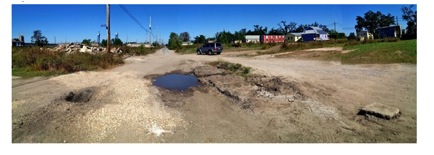New Orleans’ SuperFail
Downtown is being spruced up for the Super Bowl, but in neglected neighborhoods, roads remain unpaved.
Andy Kopsa

The Super Bowl is coming to New Orleans, the first to be held in the Crescent City since it was ripped apart by Hurricane Katrina and the catastrophic failure of the levees. Come February 3, 2013, the Superdome — now the Mercedes-Benz Superdome — will be a site of the ultimate football frenzy, instead of the reeking, impromptu shelter the country forgot.
It’s been seven years since Katrina, and New Orleans Mayor Mitch Landrieu (who took the helm after former Mayor Ray Nagin moved to Texas in a cloud of shame) is selling the Super Bowl as the city’s comeback. Landrieu has announced a brand-new streetcar line through the Central Business District to help shuttle Super Bowl-goers. The line connects four Super Bowl hot spots: the game, the parking lot designated for tailgating, the French Quarter and of course, Bourbon Street. The tailgating lot is adjacent to a Greyhound station, meaning that the streetcar line will go some way toward shoring up the city’s decimated infrastructure after the Super Bowl has come and gone. But locals are pretty sure that juxtaposition is just a happy accident.
The hype over the Super Bowl has been huge. “New Orleans is back,” gushed Saints owner Tom Benson in brief remarks at the NFL Super Bowl award announcement.
But try telling that to the people who live in the still-devastated Lower Ninth Ward or on the tattered lakefront of Lake Pontchartrain. Or to the city’s displaced population – 30 percent fewer people than before the storm still live there – now scattered around the United States since being thrown on buses and planes after Katrina hit.
Basic infrastructure in the Lower Ninth Ward isn’t just lacking — it’s non-existent. The new houses built by Brad Pitt’s Make It Right charity may look pretty when you crest the rise over the Claiborne Bridge, but they are half-vacant. People are reluctant to live in an area where few proper roads exist and basic amenities like groceries aren’t available.
Don, a resident of Pitt’s new green-friendly homes, has had a gaping hole in his road for months. Formerly paved, the road is now dirt.
 (Photo courtesy of the author)
(Photo courtesy of the author)
When I was there in October, I got out of the car to take a closer look. Water was bubbling up through the hole. Heavy construction trucks had broken a water main by driving over dirt roads unable to bear the load. Don tried for months to get the city to come out and fix it. He even asked the two sheriffs living on his block to see what they could do about it. Nothing. He told me he would maybe ask “Brad’s people” to help. But, upon a return trip this week I checked out the hole again, and the water is still flowing.
The nearby Claiborne Avenue, however, is lined with full-grown palms as part of Landrieu’s beautification project. Palms like that can cost upward of $10,000 a piece. Just south of there, Pitt’s organization is testing out a new form of concrete made from recycled materials, in keeping with its green theme. A press release explains in part:
Make It Right poured a section of pervious concrete road in our neighborhood more than a year and a half ago to test the feasibility of using it on roads in our neighborhood…Pervious roads allow water to filtrate through the concrete, reducing stress on the storm water management system and allowing groundwater to recharge as well as filtering pollutants from the water as it flows through the concrete.
Green is good, but creating a safe, revitalized community should be the priority. Without infrastructure a community cannot return. With no school, no supermarket, impassable roads and unreliable public transportation, the pretty new houses sit like decoys on a rough lake. The testing of concrete should have been completed post-haste, and certainly before Pitt’s organization invited anyone back into its Lower Ninth Ward housing project. New Orleans is not a playground to experiment with sustainable materials; it’s a living city that people call home.
I reached out to Make It Right and got no call back, so I stopped by their offices. They are on Magazine Street in the Central Business District. No one in the PR department was able to talk, but the receptionist chatted with me for a moment. She didn’t live through Katrina; she moved down afterward from Chicago. I told her about Don, his non-road and the bubbling water main running through it. I asked her why it took so long for someone to get out there and fix it. Was it a city issue? A Make It Right issue? She just shook her head and said, “These things take time.”
But this isn’t a cautionary tale about Make It Right, per se. It is a cautionary tale — particularly pertinent in the wake of Hurricane Sandy — about disaster capitalism and the way Americans respond to unspeakable devastation.
Like Katrina, Sandy drew support from well-meaning celebs (such as the recent benefit concert with Springsteen, McCartney and Jagger) and an outpouring of national support (including the outrage over Congress stonewalling a bill for aid). But eventually camera crews retreat, donations run dry, the press finds new obsessions and FEMA funds max out. Recovery is a long-term prospect. It is time we treat it that way. Short-term fixes like FEMA trailers or the temporary heaters and electricity in Mastic Beach or Staten Island are patches that can lull a weary population into thinking that help will continue to flow.
But we need to continue to agitate for a participatory, publicly funded rebuilding process for New York’s coast — and, seven years after Katrina, for the Lower Ninth Ward. If we turn our attention away, both communities will be abandoned to starry-eyed public-private development plans that do not take people’s needs into account. Neither the promise of pervious concrete nor a weekend of Super Bowl spending can substitute for paved roads.
Andy Kopsa is an award-winning investigative reporter based in New York City, though raised on an Iowa farm. Her work on government corruption, justice reform, reproductive freedom and international affairs has appeared in The New York Times, The Nation, The Guardian, Al Jazeera, Foreign Policy and others.






